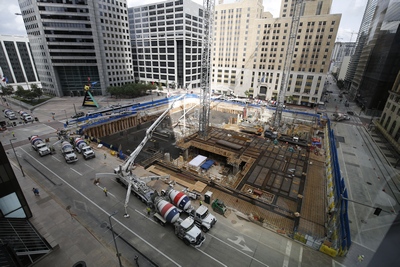
The operation went smoothly and safely, thanks to the detailed planning and coordination that began months before. This included specifying all aspects of the operation — which lasted from the afternoon of Saturday, Aug. 22 to the morning of Sunday, Aug. 23 — in a 340-page manual. Some 350 individuals worked more than 4,500 total hours without any incidents or accidents.
Click here to view the time-lapse video of the pour.
 The large volume of the pour, that it was occurring on a downtown site with limited perimeter access and the hot Texas summer weather were some of the major challenges that had to be accounted for. Skanska's approach to overcoming these hurdles included:
The large volume of the pour, that it was occurring on a downtown site with limited perimeter access and the hot Texas summer weather were some of the major challenges that had to be accounted for. Skanska's approach to overcoming these hurdles included:
- Maintaining an Injury-Free Environment: Heat stress was a major concern for all parties involved. Cooling stations equipped with tents, fan misters and ice water were provided in several locations around the site. Work hours were limited by mandatory shift changes and regular breaks to avoid exhaustion. For added assistance, an emergency medical technician was stationed onsite to monitor the well-being of the workers.
- Overcoming Site Limitations: Significant site constraints — including an active light-rail line adjacent to the long side of the mat — meant the pour had to be accomplished with only four mobile pumps, requiring exact timing of the 902 concrete deliveries. Skanska monitored the pour production in real-time throughout the duration to ensure production milestones were being met. The pour was planned and executed in 10-minute increments, which was established as the cycle time for concrete truck discharge at the pumps.
- Controlling Concrete Temperatures: To reduce the heat of hydration and minimize the risk of thermal cracking, 55 percent of the cement in the custom concrete mix was replaced with fly ash, a safe industrial byproduct that otherwise would have gone to landfill. Furthermore, aggregates were pre-cooled with water spray to reduce the placement temperature of the concrete. Concrete placement temperatures ranged from 88 F to 92 F, well below the 98 F threshold.
- Planning for “What Ifs”: Any interruption on a pour of this magnitude could have caused detrimental delays to the overall completion of the foundation. To account for potential interruptions, redundancies were built into the plan. Should one of the four concrete pumps have failed, a tow truck was on standby to tow it away and a backup pumper was stationed on site. Additional batch plants were engaged to maintain concrete production.
 Capitol Tower's construction beyond the substructure will proceed when Skanska achieves pre-leasing goals. The 750,000-square-foot Capitol Tower is Platinum pre-certified under the LEED version 4 beta program.
Capitol Tower's construction beyond the substructure will proceed when Skanska achieves pre-leasing goals. The 750,000-square-foot Capitol Tower is Platinum pre-certified under the LEED version 4 beta program.


 Join our thriving community of 70,000+ superintendents and trade professionals on LinkedIn!
Join our thriving community of 70,000+ superintendents and trade professionals on LinkedIn! Search our job board for your next opportunity, or post an opening within your company.
Search our job board for your next opportunity, or post an opening within your company. Subscribe to our monthly
Construction Superintendent eNewsletter and stay current.
Subscribe to our monthly
Construction Superintendent eNewsletter and stay current.